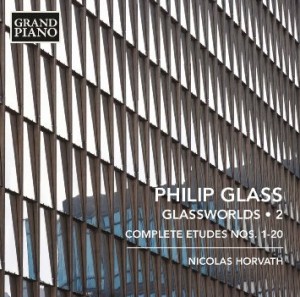Nicolas Horvath
Glassworlds 2
Music of Philip Glass
Paris-based artist Nicolas Horvath has released a new CD on the Naxos Grand Piano label titled Glassworlds 2 featuring the complete Philip Glass piano etudes, numbers 1 through 20. The etudes were begun in the mid-1990s by Glass to expand the repertoire of new music for what had become an active concert schedule for solo piano. These pieces were written after the success of Einstein on the Beach and the scoring of Koyaanisqatsi and represent something of a return by Philip Glass to his early studies as a student of Nadia Boulanger. Etudes 1 through 10 were written during the 1990s in between other works such as Hydrogen Jukebox, String Quartet No. 5 and Symphony No. 2.
These first ten etudes, known together as Book I, are technically challenging – but they are at a distinct stylistic distance from the early minimalism of, say, Music With Changing Parts that famously features repetition, limited dynamic range and static harmonies. Etude No. 1, for example, begins with four strong chords followed by rapid trilling and a crescendo-decrescendo style in the passage work that is reminiscent of the great 19th century piano virtuosi. There is a detectable echo of early minimalism here but it has been subordinated to requirements of a more demanding and expressive technique, masterfully provided on this CD by Nicolas Horvath. Etudes 3 and 4 are even more dramatically phrased, almost as if they were lifted from a piano concerto.
Etude 6 has a powerful emotional component – as well as a touch of pathos – that also lends itself to a more passionate interpretation. This etude has become a favorite of Nicolas Horvath, as he writes in the liner notes: “The only recording of Book I which was available for many years did not excite me, but while attending a recital in which the composer himself performed a selection I radically changed my view, inspired by Glass’ own poetical pianism, and helped by the hall’s acoustic, my instinct recreated them as if they were performed in a Lisztian or Rachmaninov-like manner and I suddenly understood their immense potential.”
Book 2 – Etudes 11 through 20 – were composed over a longer time period, from about 2000 onward to 2013. The music of Book 2 has a completely different point of view, as Philip Glass writes: “The first ten really have a pedagogical aspect to them for my own development. The second set have nothing or very little to do with that. I began working in the world of ideas… I did not put restrictions on the technique.” Etude 12, for example, opens with strong repeating figures that impart a complex, questioning feel along with cross currents and a swirling, unsettled aspect. Etude 13 is a frantic, slightly out of control piece, filled with powerful scales running up and down that seem almost disoriented at times. By contrast, Etude 16 is smooth and restrained, with a calm, reflective feeling that is beautifully brought out by the sensitive playing of Nicolas Horvath. Number 19 is slower with a series of single, deliberate notes in the bass line combined with nicely articulated counterpoint in the upper registers that produce a more contemporary feel. There is more variety in the Book 2 etudes and more scope for expressive technique.
Nicolas Horvath, with precise playing and imaginative interpretation has made Glassworlds 2 an indispensable reference for the serious enthusiast as well as marking an important milestone in the evolution of the music of Philip Glass.
Glassworlds 2 is available on Amazon.




















